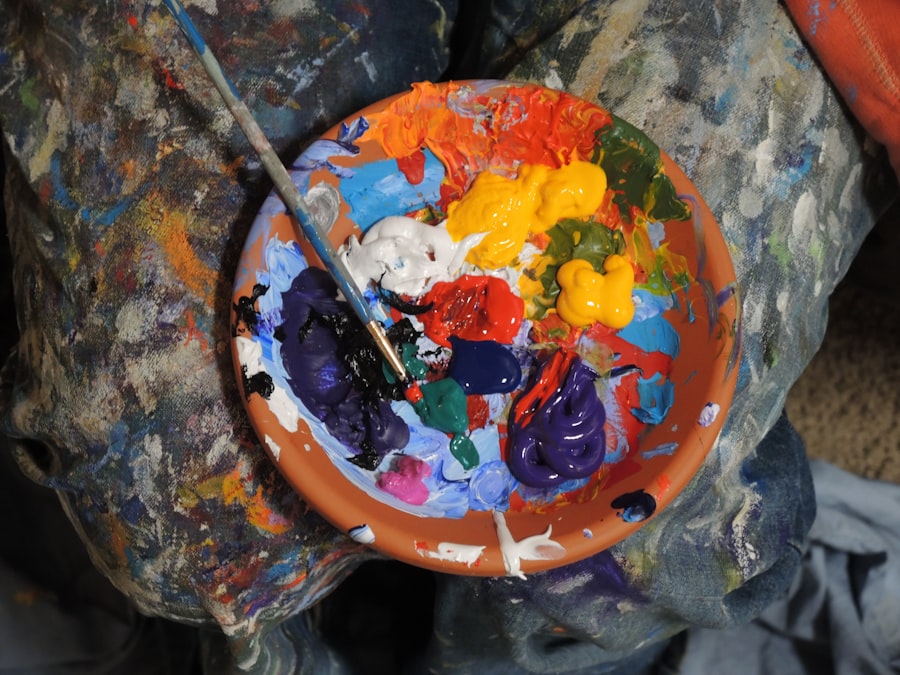
Art therapy is a therapeutic practice that integrates the creative process of making art with psychological theory and clinical practice. It is designed to help individuals express themselves, explore their emotions, and address psychological challenges through artistic expression. The fundamental premise of art therapy is that the creative process involved in artistic activities can foster healing and personal growth.
This form of therapy is particularly beneficial for those who may find it difficult to articulate their feelings verbally, as it provides an alternative medium for communication. Art therapy can be applied in various contexts, including mental health treatment, rehabilitation, and educational settings. It encompasses a wide range of artistic mediums, such as painting, drawing, sculpture, and collage, allowing clients to choose the form of expression that resonates most with them.
The role of the art therapist is to facilitate this creative process, guiding clients in exploring their thoughts and feelings while also providing a safe and supportive environment. Through this exploration, clients can gain insights into their emotional states, confront unresolved issues, and develop coping strategies.
Key Takeaways
- Art therapy is a form of therapy that uses the creative process of making art to improve and enhance the physical, mental, and emotional well-being of individuals.
- Art therapists typically hold a master’s degree in art therapy or a related field, complete supervised clinical experience, and obtain licensure or certification to practice.
- Art therapists work with clients to explore and express their feelings, improve self-esteem, manage behavior, develop social skills, and cope with stress and anxiety through various art-making techniques.
- Art therapists can work in a variety of settings including hospitals, mental health facilities, schools, rehabilitation centers, and private practice.
- The salary and job outlook for art therapists can vary depending on location, experience, and work setting, but the demand for art therapists is expected to grow in the coming years.
Education and Training Requirements for Art Therapists
Master’s Program Curriculum
The curriculum for a master’s program in art therapy typically includes coursework in psychology, human development, and various art techniques. This comprehensive education provides a solid foundation for aspiring art therapists.
Practical Experience and Certification
In addition to formal education, students are often required to complete supervised clinical internships that provide hands-on experience working with clients in therapeutic settings. Furthermore, aspiring art therapists must obtain licensure or certification to practice professionally. In the United States, this typically involves passing a national examination administered by the Art Therapy Credentials Board (ATCB).
This rigorous training ensures that art therapists are well-equipped to handle the complexities of mental health issues while utilizing art as a therapeutic tool.
Job Duties and Responsibilities of Art Therapists

Art therapists engage in a variety of tasks aimed at promoting emotional healing and personal development among their clients. One of their primary responsibilities is to assess clients’ needs and develop individualized treatment plans that incorporate artistic activities tailored to each person’s unique circumstances. This assessment process often involves interviews, questionnaires, and observation of the client’s artistic expression to gain insights into their emotional state and psychological challenges.
In addition to conducting assessments and creating treatment plans, art therapists facilitate art-making sessions where clients can explore their feelings through creative expression. During these sessions, therapists provide guidance and support while encouraging clients to experiment with different materials and techniques. They also help clients interpret their artwork, fostering discussions that can lead to deeper self-awareness and understanding.
Documentation of client progress is another critical aspect of an art therapist’s role, as it allows for ongoing evaluation of treatment effectiveness and adjustments as needed.
Work Settings for Art Therapists
| Work Setting | Percentage of Art Therapists |
|---|---|
| Hospitals | 25% |
| Private Practice | 20% |
| Community Centers | 15% |
| Schools | 10% |
| Rehabilitation Centers | 10% |
| Correctional Facilities | 5% |
| Other | 15% |
Art therapists can be found in a diverse array of work environments, reflecting the versatility of the profession. Many art therapists work in mental health facilities, such as hospitals or outpatient clinics, where they provide therapeutic services to individuals dealing with various psychological issues, including anxiety, depression, trauma, and substance abuse. In these settings, art therapy can be an integral part of a comprehensive treatment plan that may also include traditional talk therapy or medication management.
Educational institutions also employ art therapists to support students facing emotional or behavioral challenges. In schools, they may work with children who have experienced trauma or those with special needs, using art as a means to enhance communication skills and emotional regulation. Additionally, art therapists may find opportunities in community centers, rehabilitation facilities, or private practice settings.
Each of these environments presents unique challenges and rewards, allowing art therapists to tailor their approaches based on the specific needs of their clientele.
Salary and Job Outlook for Art Therapists
The salary for art therapists can vary significantly based on factors such as geographic location, level of experience, and the specific work setting. According to data from the U.S. Bureau of Labor Statistics (BLS), the median annual wage for art therapists falls within the range of $40,000 to $70,000.
Those working in metropolitan areas or specialized facilities may earn higher salaries due to increased demand for mental health services and the unique skills that art therapists bring to the table. The job outlook for art therapists appears promising as awareness of mental health issues continues to grow. The BLS projects that employment for art therapists will increase as more individuals seek alternative forms of therapy that incorporate creative expression.
This trend is particularly evident among populations such as children and adolescents who may benefit from non-verbal methods of communication. As society increasingly recognizes the importance of mental health care, the demand for qualified art therapists is expected to rise.
Skills and Qualities Needed to Succeed as an Art Therapist

Interpersonal Skills: Building Trust and Rapport
Strong interpersonal skills are essential, as art therapists work closely with clients from diverse backgrounds who may be experiencing significant emotional distress. The ability to build rapport and establish trust is crucial for creating a safe space where clients feel comfortable expressing themselves through art.
Creativity and Artistic Proficiency
In addition to interpersonal skills, creativity is a vital attribute for art therapists. They must not only be proficient in various artistic techniques but also be able to think outside the box when it comes to facilitating sessions and engaging clients in meaningful ways. Furthermore, a solid understanding of psychological principles is necessary for effectively interpreting clients’ artwork and guiding them through their therapeutic journey.
Personal Qualities: Empathy, Patience, and Adaptability
Empathy, patience, and adaptability are also important qualities that enable art therapists to respond sensitively to clients’ needs and adjust their approaches as required.
Advantages and Challenges of a Career in Art Therapy
A career in art therapy offers numerous advantages that can be deeply fulfilling for those passionate about both art and mental health. One significant benefit is the opportunity to make a meaningful impact on individuals’ lives by helping them navigate their emotional struggles through creative expression. Many art therapists find great satisfaction in witnessing their clients’ progress and personal growth over time.
However, like any profession in the mental health field, art therapy comes with its own set of challenges. The emotional toll of working with clients who are experiencing trauma or severe psychological distress can be significant. Art therapists must practice self-care and seek supervision or peer support to manage their own emotional well-being effectively.
Additionally, securing employment can sometimes be competitive due to the limited number of positions available in certain regions or specialized settings.
Steps to Pursue a Career as an Art Therapist in the USA
For those interested in pursuing a career as an art therapist in the United States, several steps must be taken to achieve this goal. The first step typically involves obtaining a bachelor’s degree in a relevant field such as psychology or fine arts. This foundational education provides essential knowledge about human behavior and artistic techniques.
Following this initial step, aspiring art therapists should enroll in an accredited master’s program in art therapy or a related discipline. During this time, students will engage in both theoretical coursework and practical training through supervised internships. After completing their degree program, candidates must then pursue licensure or certification by passing the national examination offered by the Art Therapy Credentials Board (ATCB).
Finally, ongoing professional development through workshops or additional training can enhance skills and keep practitioners informed about new developments in the field. By following these steps and committing to continuous learning and self-reflection, individuals can embark on a rewarding career path that combines their passion for art with a desire to help others heal emotionally through creative expression.
If you are interested in learning more about careers in the USA, specifically in the field of art therapy, you may want to check out this article on sample page to get a better idea of the resources available on the site.
FAQs
What is art therapy?
Art therapy is a form of therapy that uses the creative process of making art to improve a person’s physical, mental, and emotional well-being. It is often used as a form of treatment for individuals dealing with trauma, stress, anxiety, depression, and other mental health issues.
What do art therapists do?
Art therapists are trained mental health professionals who use art-making as a form of therapy to help individuals explore their emotions, improve self-esteem, manage behavior, and develop social skills. They work with a wide range of clients, including children, adolescents, adults, and the elderly.
What qualifications are required to become an art therapist in the USA?
To become an art therapist in the USA, individuals typically need to complete a master’s degree in art therapy or a related field. They also need to complete supervised clinical experience and obtain licensure or certification, depending on the state in which they plan to practice.
What settings do art therapists work in?
Art therapists can work in a variety of settings, including hospitals, mental health clinics, schools, rehabilitation centers, nursing homes, and private practice. They may also work with specific populations, such as veterans, individuals with developmental disabilities, or survivors of trauma.
What is the job outlook for art therapists in the USA?
According to the Bureau of Labor Statistics, the demand for art therapists is expected to grow as more people recognize the benefits of art therapy for mental health treatment. As a result, job opportunities for art therapists are expected to increase in the coming years.



